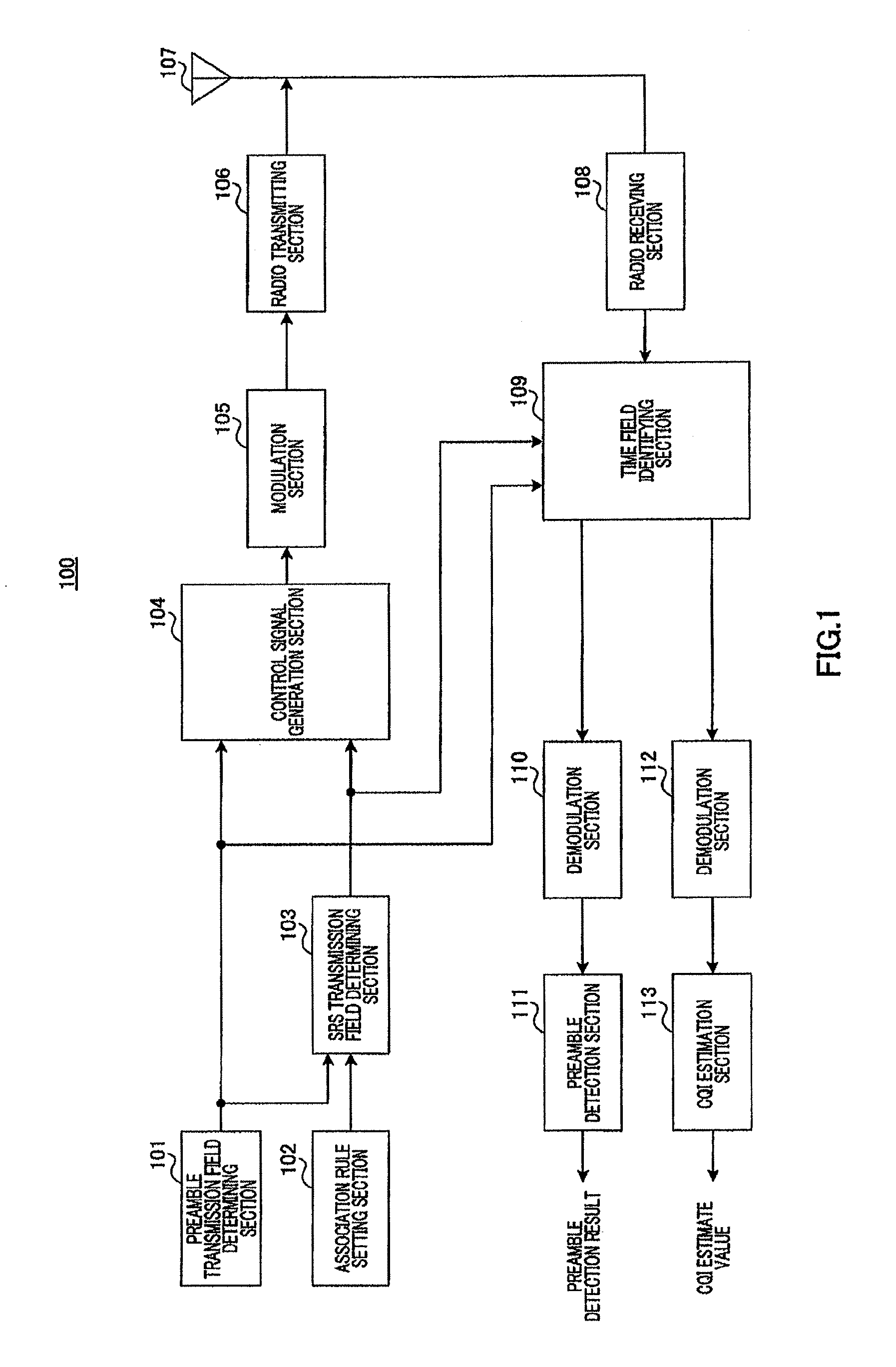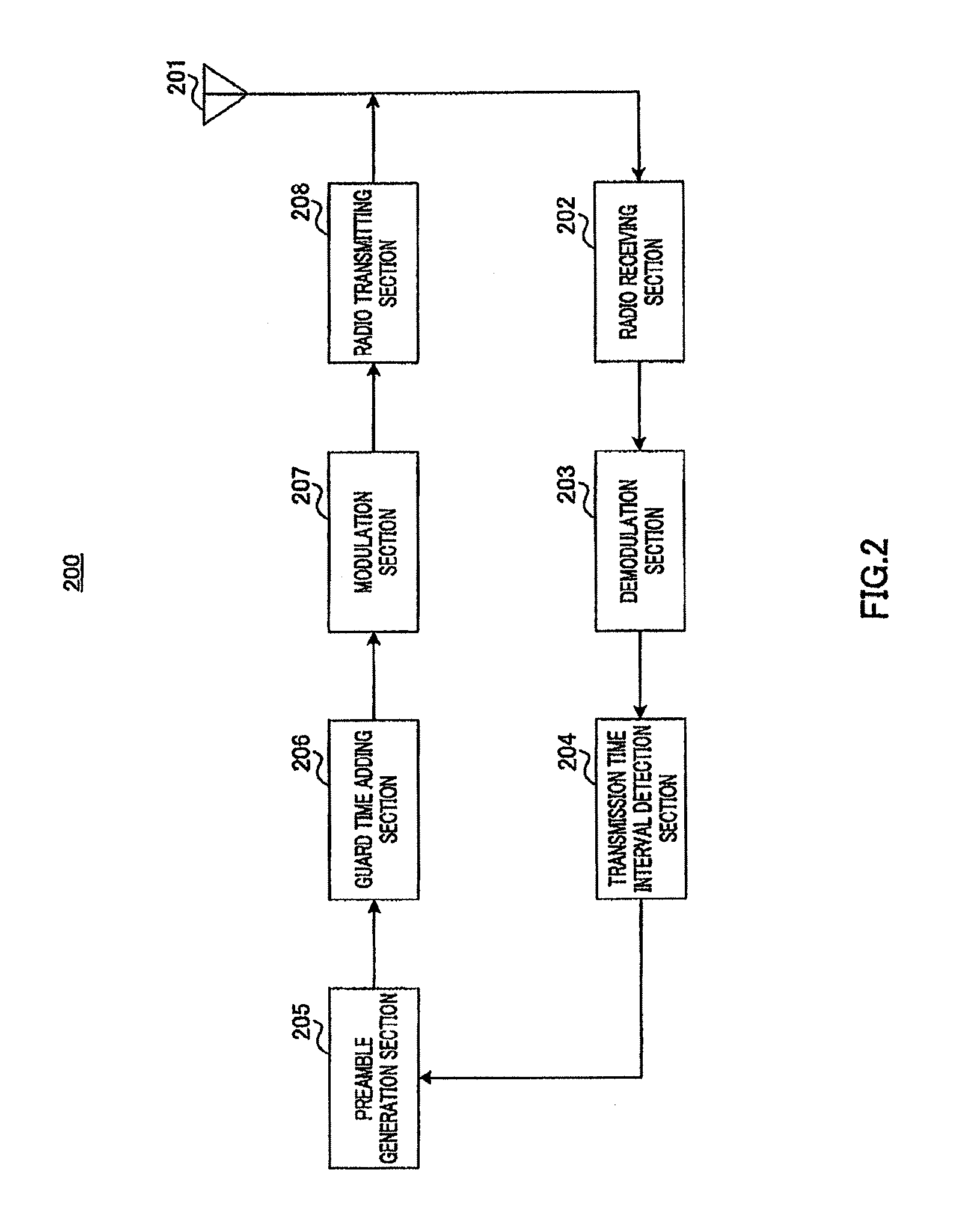Radio communication base station device and correlation setting method
a technology of radio communication and base station, applied in multiplex communication, orthogonal multiplex, wireless commuication services, etc., can solve the problems of data transmission efficiency reduction and communication resources available for data transmission, and achieve the effect of reducing the amount of communication resources used for srss
- Summary
- Abstract
- Description
- Claims
- Application Information
AI Technical Summary
Benefits of technology
Problems solved by technology
Method used
Image
Examples
embodiment 1
[0026]FIG. 1 shows a configuration of base station 100 according to the present embodiment. Base station 100 receives a preamble from mobile station 200 (FIG. 2) which will be described later and receives an SRS from mobile station 300 (FIG. 3) which will be described later.
[0027]Preamble transmission field determining section 101 determines the time interval of the transmission time field (subframe) in which the mobile station can transmit a preamble. Preamble transmission field determining section 101 then outputs the determined preamble transmission time interval to SRS transmission field determining section 103, control signal generation section 104 and time field identifying section 109.
[0028]Association rule setting section 102 sets rules for associating the transmission time intervals for the preamble and SRS. Association rule setting section 102 then outputs the association rules set, to SRS transmission field determining section 103. Details of the setting of the associatio...
embodiment 2
[0083]In the present embodiment, an SRS is arranged at the beginning of a preamble transmission time field.
[0084]Guard time adding section 206 (FIG. 2) of mobile station 200 according to the present embodiment adds a guard time of the same time length as the SRS length before the preamble inputted from preamble generation section 205 and also adds a guard time of a time length corresponding to (1 subframe length—preamble length—SRS length) after the preamble.
[0085]On the other hand, when arranging an SRS in a preamble transmission time field (subframe), arrangement section 307 (FIG. 3) of mobile station 300 according to the present embodiment arranges the SRS at the beginning of the preamble transmission time field (subframe).
[0086]This will be explained more specifically below. Here, suppose the preamble transmission time field is formed with 14 LBs and the time length of the SRS is 1 LB as with Embodiment 1.
[0087]Therefore, as shown in FIG. 7, arrangement section 307 arranges the ...
embodiment 3
[0090]A case has been described with Embodiment 1 where the preamble and SRS transmission time fields are made to match each other, but a case will be explained now with the present embodiment where the preamble and SRS transmission time fields and the transmission band are made to match each other.
[0091]This will be explained more specifically below. In the following explanations, suppose that preambles and SRSs are transmitted using frequency hopping.
[0092]FIG. 8 shows a configuration of base station 400 according to the present embodiment. In FIG. 8, the same components as those in Embodiment 1 (FIG. 1) will be assigned the same reference numerals, and explanations thereof will be omitted.
[0093]Preamble transmission field determining section 401 of base station 400 according to the present embodiment determines a time interval (subframe) in which each mobile station can transmit the preamble and a transmission band in which the preamble can be transmitted.
[0094]Association rule s...
PUM
 Login to View More
Login to View More Abstract
Description
Claims
Application Information
 Login to View More
Login to View More - R&D
- Intellectual Property
- Life Sciences
- Materials
- Tech Scout
- Unparalleled Data Quality
- Higher Quality Content
- 60% Fewer Hallucinations
Browse by: Latest US Patents, China's latest patents, Technical Efficacy Thesaurus, Application Domain, Technology Topic, Popular Technical Reports.
© 2025 PatSnap. All rights reserved.Legal|Privacy policy|Modern Slavery Act Transparency Statement|Sitemap|About US| Contact US: help@patsnap.com



